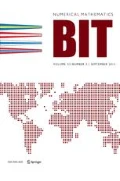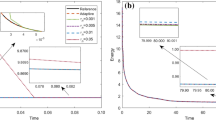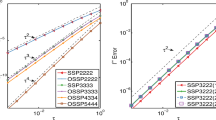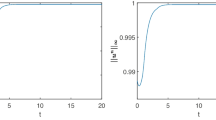Abstract
The space fractional Cahn–Hilliard phase-field model is more adequate and accurate in the description of the formation and phase change mechanism than the classical Cahn–Hilliard model. In this article, we propose a temporal second-order energy stable scheme for the space fractional Cahn–Hilliard model. The scheme is based on the second-order backward differentiation formula in time and a finite difference method in space. Energy stability and convergence of the scheme are analyzed, and the optimal convergence orders in time and space are illustrated numerically. Note that the coefficient matrix of the scheme is a \(2 \times 2\) block matrix with a Toeplitz-like structure in each block. Combining the advantages of this special structure with a Krylov subspace method, a preconditioning technique is designed to solve the system efficiently. Numerical examples are reported to illustrate the performance of the preconditioned iteration.





Similar content being viewed by others
References
Abels, H., Bosia, S., Grasselli, M.: Cahn–Hilliard equation with nonlocal singular free energies. Ann. Mat. Pura Appl. 194, 1071–1106 (2015)
Acosta, G., Borthagaray, J.P.: A fractional Laplace equation: regularity of solutions and finite element approximations. SIAM J. Numer. Anal. 55, 472–495 (2017)
Ainsworth, M., Mao, Z.: Analysis and approximation of a fractional Cahn–Hilliard equation. SIAM J. Numer. Anal. 55, 1689–1718 (2017)
Ainsworth, M., Mao, Z.: Well-posedness of the Cahn–Hilliard equation with fractional free energy and its Fourier Galerkin approximation. Chaos, Solitons Fractals 102, 264–273 (2017)
Akagi, G., Schimperna, G., Segatti, A.: Fractional Cahn–Hilliard, Allen–Cahn and porous medium equations. J. Differ. Equ. 261, 2935–2985 (2016)
Barrett, J., Blowey, J.: Finite element approximation of the Cahn–Hilliard equation with concentration dependent mobility. Math. Comput. 68, 487–517 (1999)
Bertozzi, A.L., Esedoglu, S., Gillette, A.: Inpainting of binary images using the Cahn–Hilliard equation. IEEE Trans. Image Process. 16, 285–291 (2006)
Bu, L., Mei, L., Hou, Y.: Stable second-order schemes for the space-fractional Cahn–Hilliard and Allen–Cahn equations. Comput. Math. Appl. 78, 3485–3500 (2019)
Bu, L., Mei, L., Wang, Y., Hou, Y.: Energy stable numerical schemes for the fractional-in-space Cahn–Hilliard equation. Appl. Numer. Math. 158, 392–414 (2020)
Cahn, J.W., Hilliard, J.E.: Free energy of a nonuniform system. I. Interfacial free energy. J. Chem. Phys. 28, 258–267 (1958)
Cai, M., Li, C.: On Riesz derivative. Fract. Calc. Appl. Anal. 22, 287–301 (2019)
Chan, R., Jin, X.Q.: An Introduction to Iterative Toeplitz Solvers. SIAM, Philadelphia (2007)
Chen, H., Sheng, C., Wang, L.L.: On explicit form of the FEM stiffness matrix for the integral fractional Laplacian on non-uniform meshes. Appl. Math. Lett. 113, 106864 (2021). https://doi.org/10.1016/j.aml.2020.106864
Chen, W., Wang, X., Yan, Y., Zhang, Z.: A second order BDF numerical scheme with variable steps for the Cahn–Hilliard equation. SIAM J. Numer. Anal. 57, 495–525 (2019)
Cheng, K., Feng, W., Wang, C., Wise, S.M.: An energy stable fourth order finite difference scheme for the Cahn–Hilliard equation. J. Comput. Appl. Math. 362, 574–595 (2019)
Cohen, D.S., Murray, J.D.: A generalized diffusion model for growth and dispersal in a population. J. Math. Biol. 12, 237–249 (1981)
Duo, S., van Wyk, H.W., Zhang, Y.: A novel and accurate finite difference method for the fractional Laplacian and the fractional Poisson problem. J. Comput. Phys. 355, 233–252 (2018)
Duo, S., Zhang, Y.: Accurate numerical methods for two and three dimensional integral fractional Laplacian with applications. Comput. Methods Appl. Mech. Eng. 355, 639–662 (2019)
Elliott, C.M., French, D.A., Milner, F.: A second order splitting method for the Cahn–Hilliard equation. Numer. Math. 54(5), 575–590 (1989)
Farshbaf-Shaker, M.H., Heinemann, C.: A phase field approach for optimal boundary control of damage processes in two-dimensional viscoelastic media. Math. Models Methods Appl. Sci. 25, 2749–2793 (2015)
Feng, X., Li, Y., Xing, Y.: Analysis of mixed interior penalty discontinuous Galerkin methods for the Cahn–Hilliard equation and the Hele–Shaw flow. SIAM J. Numer. Anal. 54, 825–847 (2016)
Gu, X.M., Huang, T.Z., Ji, C.C., Carpentieri, B., Alikhanov, A.A.: Fast iterative method with a second-order implicit difference scheme for time-space fractional convection-diffusion equation. J. Sci. Comput. 72, 957–985 (2017)
Gu, X.M., Sun, H.W., Zhang, Y., Zhao, Y.L.: Fast implicit difference schemes for time-space fractional diffusion equations with the integral fractional Laplacian. Math. Methods Appl. Sci. 44, 441–463 (2021)
Klapper, I., Dockery, J.: Role of cohesion in the material description of biofilms. Phys. Rev. E 74, 031,902 (2006). https://doi.org/10.1103/PhysRevE.74.031902
Kwaśnicki, M.: Ten equivalent definitions of the fractional Laplace operator. Fract. Calc. Appl. Anal. 20, 7–51 (2017)
Landkof, N.S.: Foundations of Modern Potential Theory. Springer, New York, Heidelberg (1972)
Lei, S.L., Sun, H.W.: A circulant preconditioner for fractional diffusion equations. J. Comput. Phys. 242, 715–725 (2013)
Li, M., Gu, X.M., Huang, C., Fei, M., Zhang, G.: A fast linearized conservative finite element method for the strongly coupled nonlinear fractional Schrödinger equations. J. Comput. Phys. 358, 256–282 (2018)
Li, Q., Mei, L.: Efficient, decoupled, and second-order unconditionally energy stable numerical schemes for the coupled Cahn–Hilliard system in copolymer/homopolymer mixtures. Comput. Phys. Commun. 260, 107290 (2020). https://doi.org/10.1016/j.cpc.2020.107290
Li, Q., Mei, L., You, B.: A second-order, uniquely solvable, energy stable BDF numerical scheme for the phase field crystal model. Appl. Numer. Math. 134, 46–65 (2018)
Li, M., Zhao, Y.L.: A fast energy conserving finite element method for the nonlinear fractional Schrödinger equation with wave operator. Appl. Math. Comput. 338, 758–773 (2018)
Liu, H., Cheng, A., Wang, H., Zhao, J.: Time-fractional Allen–Cahn and Cahn–Hilliard phase-field models and their numerical investigation. Comput. Math. Appl. 76, 1876–1892 (2018)
Macías-Díaz, J.E.: A structure-preserving method for a class of nonlinear dissipative wave equations with Riesz space-fractional derivatives. J. Comput. Phys. 351, 40–58 (2017)
Ng, M.K.: Iterative Methods for Toeplitz Systems. Oxford University Press, New York (2004)
Ortigueira, M.D.: Riesz potential operators and inverses via fractional centred derivatives. Int. J. Math. Math. Sci. 2006, 048391 (2006). https://doi.org/10.1155/IJMMS/2006/48391
Ran, M., Zhang, C.: A conservative difference scheme for solving the strongly coupled nonlinear fractional Schrödinger equations. Commun. Nonlinear Sci. Numer. Simul. 41, 64–83 (2016)
Roy, T., Jönsthövel, T.B., Lemon, C., Wathen, A.J.: A block preconditioner for non-isothermal flow in porous media. J. Comput. Phys. 395, 636–652 (2019)
Saad, Y.: Iterative Methods for Sparse Linear Systems, 2nd edn. SIAM, Philadelphia (2003)
Samko, S.G., Kilbas, A.A., Marichev, O.I.: Fractional Integrals and Derivatives. Gordon and Breach Science Publishers, Yverdon (1993)
Southworth, B.S., Olivier, S.A.: A note on \(2 \times 2\) block-diagonal preconditioning, p. 13 (2020). ArXiv preprint https://arxiv.org/abs/2001.00711
Tang, T., Yu, H., Zhou, T.: On energy dissipation theory and numerical stability for time-fractional phase-field equations. SIAM J. Sci. Comput. 41, A3757–A3778 (2019)
Varga, R.S.: Geršgorin and His Circles. Springer, Berlin (2004)
Wang, F., Chen, H., Wang, H.: Finite element simulation and efficient algorithm for fractional Cahn–Hilliard equation. J. Comput. Appl. Math. 356, 248–266 (2019)
Weng, Z., Huang, L., Wu, R.: Numerical approximation of the space fractional Cahn-Hilliard equation. Math. Probl. Eng. 2019, 3163702 (2019). https://doi.org/10.1155/2019/3163702
Weng, Z., Zhai, S., Feng, X.: A Fourier spectral method for fractional-in-space Cahn–Hilliard equation. Appl. Math. Model. 42, 462–477 (2017)
Wise, S., Kim, J., Lowengrub, J.: Solving the regularized, strongly anisotropic Cahn–Hilliard equation by an adaptive nonlinear multigrid method. J. Comput. Phys. 226(1), 414–446 (2007)
Yan, Y., Chen, W., Wang, C., Wise, S.M.: A second-order energy stable BDF numerical scheme for the Cahn–Hilliard equation. Commun. Comput. Phys. 23(2), 572–602 (2018)
Zhai, S., Wu, L., Wang, J., Weng, Z.: Numerical approximation of the fractional Cahn–Hilliard equation by operator splitting method. Numer. Algorithms 84(3), 1–24 (2019). https://doi.org/10.1007/s11075-019-00795-7
Zhao, Y.L., Zhu, P.Y., Gu, X.M., Zhao, X.L., Cao, J.: A limited-memory block bi-diagonal Toeplitz preconditioner for block lower triangular Toeplitz system from time-space fractional diffusion equation. J. Comput. Appl. Math. 362, 99–115 (2019)
Zhao, Y.L., Zhu, P.Y., Gu, X.M., Zhao, X.L., Jian, H.Y.: A preconditioning technique for all-at-once system from the nonlinear tempered fractional diffusion equation. J. Sci. Comput. 83, 10 (2020). https://doi.org/10.1007/s10915-020-01193-1
Acknowledgements
This research is supported by the National Natural Science Foundation of China (Nos. 11801527, 61876203, 61772003, 11801463 and 11701522) and the Applied Basic Research Program of Sichuan Province (No. 2020YJ0007). The first author is also supported by the China Scholarship Council. We would like to express our sincere thanks to the referees for insightful comments and invaluable suggestions that greatly improved the representation of this paper.
Author information
Authors and Affiliations
Corresponding author
Additional information
Communicated by Marko Huhtanen.
Publisher's Note
Springer Nature remains neutral with regard to jurisdictional claims in published maps and institutional affiliations.
Appendix
Appendix
In this appendix, the convergence orders of (3.2) with lower spatial regularity are provided.
Example A
Consider Example 1 with the exact solution and source terms given by
and
respectively.
The errors and the convergence orders are listed in Tables 5 and 6. They show that the convergence order of our scheme (3.2) is \(\mathcal {O}(\tau ^2 + h^2)\). Comparing with the work [17], the convergence order of space is higher than \(1 - \frac{\alpha }{2}\).
Example B
In this example, we consider SFCH (1.1) with a solution that has lower regularity than that of Example A. More precisely, consider Example 1 with the exact solution and source terms given by
and
respectively.
The numerical errors and the observed convergence orders are listed in Table 7. It can be seen that for this lower regularity solution, the observed convergence order is almost \(\alpha /2\).
Rights and permissions
About this article
Cite this article
Zhao, YL., Li, M., Ostermann, A. et al. An efficient second-order energy stable BDF scheme for the space fractional Cahn–Hilliard equation. Bit Numer Math 61, 1061–1092 (2021). https://doi.org/10.1007/s10543-021-00843-6
Received:
Accepted:
Published:
Issue Date:
DOI: https://doi.org/10.1007/s10543-021-00843-6
Keywords
- Space fractional Cahn–Hilliard equation
- Energy stability
- Convergence
- Newton’s method
- Krylov subspace method
- Preconditioning




